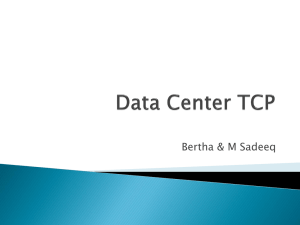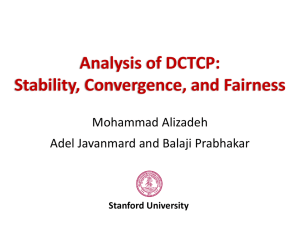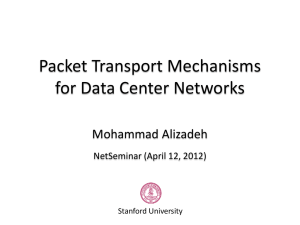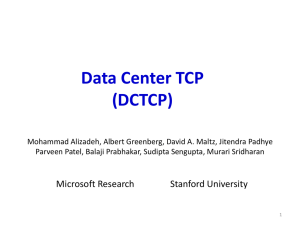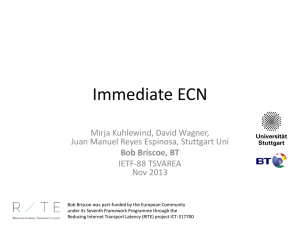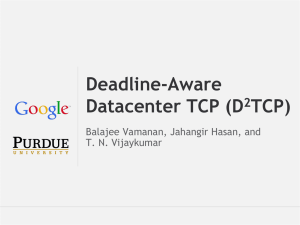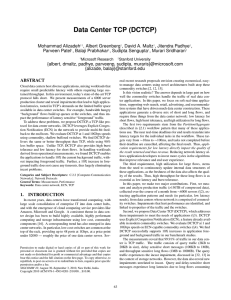tdctcp - csie.org
advertisement
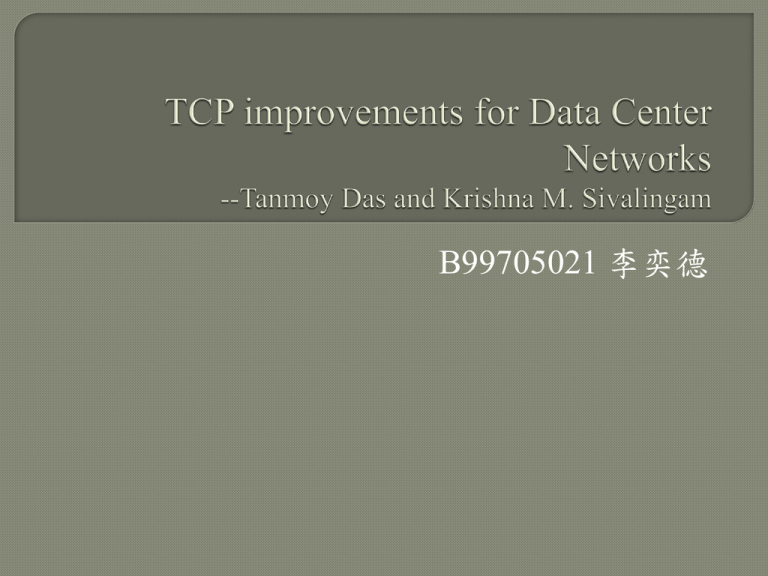
B99705021 李奕德 Abstract Intro ECN in DCTCP TDCTCP Performance evaluation conclusion TCP does not fit in datacenter DCTCP may lower throughput due to small buffer size Improved version of DCTCP (called TDCTCP) Compare to existed algorithm (DCTCP, TCPNewReno) TDCTCP may have slightly higher delay but have much better throughput in general Abstract Intro ECN in DCTCP TDCTCP Performance evaluation conclusion Data 1. 2. flow in datacenter: large data flow require high throughput small data flow require low latency Incast problem TCP: provide : reliable, ordered byte stream does not provide: high throughput with “simultaneously low delay” Other similar solutions: DCTCP, TCPNewReno, TDCTCP Tested under OMNeT++ simulator Abstract Intro ECN in DCTCP TDCTCP Performance evaluation conclusion ECN mechanism 2-bit used to describe current situation 00: Non ECN-Capable Transport — Non-ECT 10: ECN Capable Transport — ECT(0) 01: ECN Capable Transport — ECT(1) 11: Congestion Encountered — CE Abstract Intro ECN in DCTCP TDCTCP Performance evaluation conclusion A. Modification of Congestion Avoidance B. Resetting α after Delayed ACK timeout C. Dynamic Delayed ACK timeout calculation Modification of Congestion Avoidance α = fraction of marked packets in one congestion window Indicates current congestion level = Maximum Segment Size Indicates the size of data that can be sent MSS α after Delayed ACK timeout delayed ACK timeout: use in TCP to reduce ACKs send to the sender When ACK timeout occur: 1. α is not updated 2. Old α remain high and block increment of window size α is reset to 0 after every delayed ACK timeout Resetting Set α to 0 when this happen Dynamic Delayed ACK timeout calculation DCTCP: small buffer = small congestion window Congestion window reduce to 1, causing ACK timeouts Packet arrival follows an exponential distribution Packet loss probability in the network is small Use 10 flows to demonstrate Low variance in window size Spend less time in ACK timeout Abstract Intro ECN in DCTCP TDCTCP Performance evaluation conclusion Throughput Fairness Delay Queue length Variation in Delay Variation in Throughput Environment Throughput Better - single bottleneck, 1Gbps performance than DCTCP in general Throughput Better - single bottleneck, 10Gbps than DCTCP under smaller K Provide same throughput as TCPNewReno in early stages Throughput Better – multi-bottleneck, 10Gbps than DCTCP under smaller K Provide same throughput as TCPNewReno in early stages Fairness- better single bottleneck, measure in JFI fairness in every scenario Fairness- multi-bottleneck, measure in JFI Delay- single bottleneck , 10 Gbps TCPNewReno is good except high delay Delay- multi-bottleneck , 10 Gbps Queue length TDCTCP is slightly longer than DCTCP Variation in Delay Variation in throughput Abstract Intro ECN in DCTCP TDCTCP Performance evaluation conclusion Modified DCTCP => TDCTCP 15% higher throughput than DCTCP improved fairness compare to DCTCP provides more stable throughput queue length is slightly more than that of DCTCP at 10Gbps delay is slightly higher than that of DCTCP Any questions??
